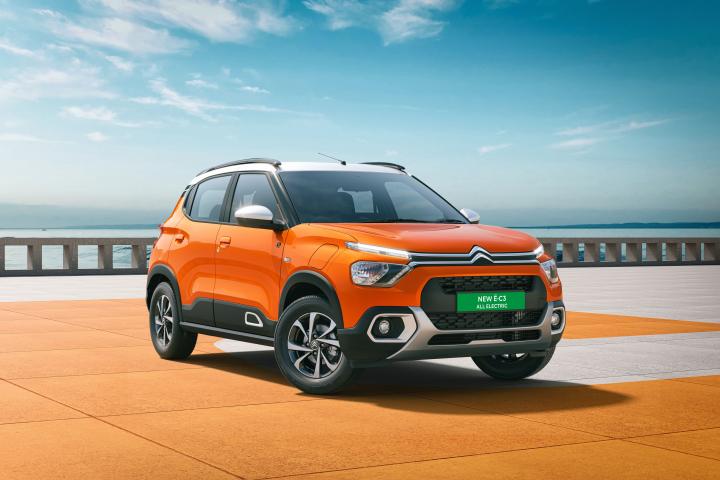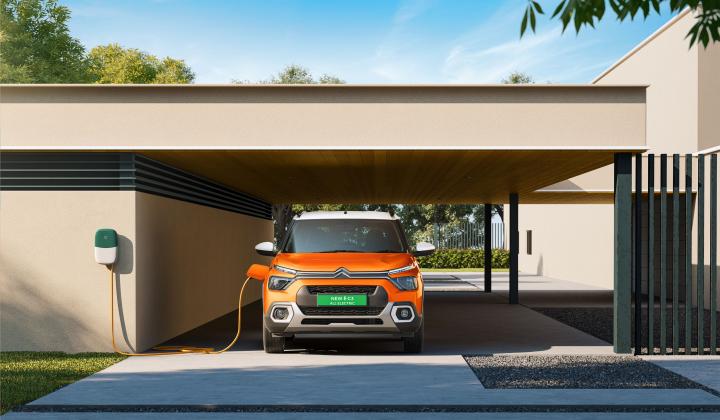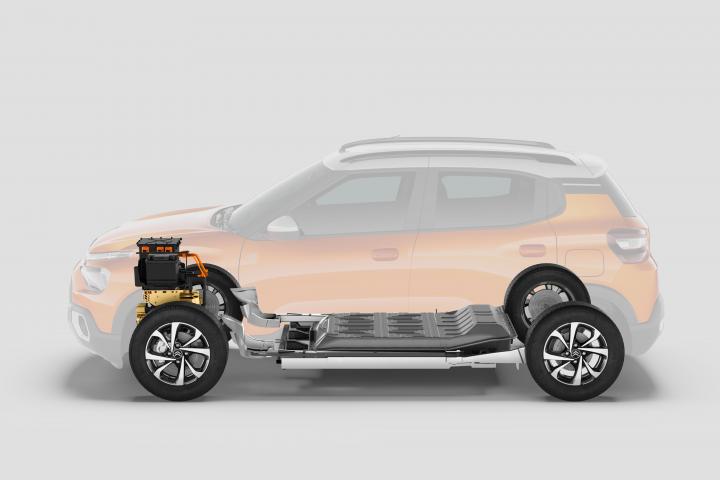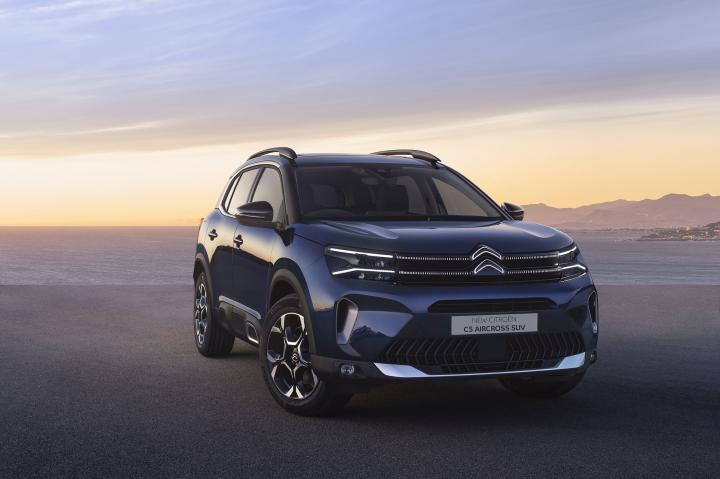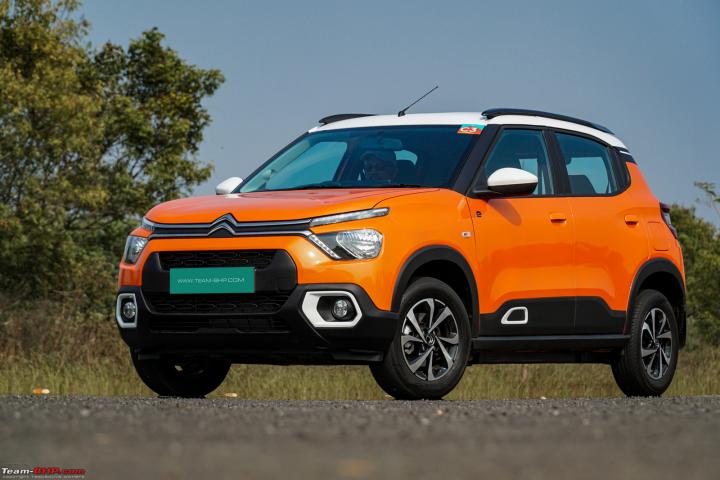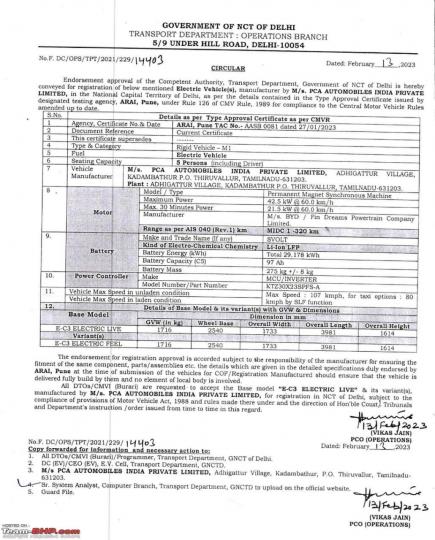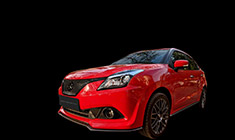News
Top-spec Citroen C3 Shine variant launched at Rs 7.60 lakh
The Shine variants get 35 connected features that are part of the My Citroen Connect app.
Citroen has introduced a new top-spec variant of the C3 called the 'Shine'. It is priced in the range of Rs 7.60-8.92 lakh (ex-showroom).
The top-of-the-line 'Shine' variant comes equipped with 13 new features. These include electrically adjustable ORVMs, a rear parking camera, day/night IRVM, 15-inch diamond-cut alloy wheels, front fog lamps, rear skid plates, a rear wiper, a washer and a defogger. It also gets 35 connected features that are part of the My Citroen Connect app.
The Shine variant of the Citroen C3 is powered by a 1.2-litre naturally aspirated petrol engine that produces 81 BHP and 115 Nm and is paired with a 5-speed manual transmission. The crossover also comes with a 1.2-litre turbo-petrol engine that makes 109 BHP and 190 Nm. This engine is mated to a 6-speed manual gearbox.
Citroen C3 updated ex-showroom prices:
- Live – Rs 6.16 lakh
- Feel – Rs 7.08 lakh
- Feel Vibe Pack – Rs 7.23 lakh
- Feel Dual Tone – Rs 7.23 lakh
- Feel Dual Tone Vibe Pack – Rs 7.38 lakh
- Shine – Rs 7.60 lakh
- Shine Vibe Pack – Rs 7.72 lakh
- Shine Dual Tone – Rs 7.75 lakh
- Shine Dual Tone Vibe Pack – Rs 7.87 lakh
- Tags:
- Indian
- C3
- Citroen C3
News
Citroen C3 could get a top-spec Shine trim with extra features
The Citroen C3 could soon be available in three trims: Live, Feel and a new top-spec Shine variant.
The Citroen C3 competes in the subcompact SUV segment but lacks quite a few features offered by its rivals. The French carmaker realizes this and is rumoured to introduce a new top-spec variant.
According to a media report, the C3 could soon be available in Shine trim. It will sit above the Live and Feel trims, making the latter the new mid-spec variant.
The Shine variant could be equipped with a rear wiper, washer and defogger, alloy wheels, electric folding ORVMs, engine start/stop button and a rearview camera. The 10.25-inch touchscreen infotainment system and digital instrument cluster are likely to be carried over unchanged.
Reports suggest that customers opting for the Citroen C3 Shine trim could get the option of a 1.2-litre naturally aspirated petrol that makes 81 BHP and 115 Nm and a 1.2-litre turbo-petrol unit producing 108 BHP and 190 Nm. Transmission options are also expected to remain unchanged, with the former getting a 5-speed manual, while the latter will be paired with a 6-speed manual gearbox.
Source: Zigwheels
- Tags:
- Indian
- Citroen C3
- C3
News
Citroen C3 exports commence from India
The Citroen C3 will be exported to Africa and ASEAN countries.
Citroen India has commenced exports of the C3 crossover to countries in Africa and the ASEAN region. The first batch of cars was recently dispatched from the Kamarajar port.
The Citroen C3 was launched in India back in July 2022. It is available in two variants: Live and Feel.
The C3 is based on the CMP modular platform. It features a funky exterior design, which is typical for the brand. Inside, it gets a dual-tone dashboard with a 10.1-inch touchscreen infotainment system with Android Auto and Apple CarPlay connectivity and a digital instrument cluster.
In India, the C3 is available with two engine options. These include a 1.2-litre naturally aspirated petrol engine that makes 81 BHP @ 5,750 rpm and 115 Nm @ 3,750 rpm, paired with a 5-speed manual and a 1.2-litre turbo-petrol motor producing 108 BHP @ 5,500 rpm and 190 Nm @ 1,750 rpm, mated to a 6-speed manual transmission.
- Tags:
- Indian
- Citroen C3
- C3
- Export
News
Citroen mid-size SUV to be unveiled on April 27
Citroen's new mid-size SUV is expected to compete with the likes of the Hyundai Creta, Kia Seltos and Maruti Grand Vitara.
Citroen is all set to unveil its new mid-size SUV for the Indian market on April 27. The new model is expected to compete with the likes of the Hyundai Creta, Kia Seltos and Maruti Grand Vitara.
The new Citroen SUV (codenamed: CC24) will be based on the CMP modular platform. It is expected to have a wheelbase of 2.62 metres and an overall length of 4.40 metres.
Spy images suggest that the design of the upcoming 3-row SUV will be similar to the Citroen C3 currently sold in India. As per reports, the car will feature a split-headlamp design, a 2-slat chrome grille and alloy wheels. It is expected to get a dual-tone interior with a touchscreen infotainment system.
At present, the C3 sold in India is offered with a 1.2-litre petrol engine that makes 81 BHP and 115 Nm and a 1.2-litre turbo-petrol engine producing 108 BHP and 190 Nm. It is said that the 7-seater model could come with a turbo-petrol engine.
- Tags:
- Indian
- Citroen C3
- C3 Aircross
- C3
News
Citroen eC3 electric hatchback launched at Rs 11.50 lakh
The Citroen eC3 competes with the Tata Tiago EV in the entry-level EV segment.
Prices for the Citroen eC3 are out. The French brand’s first electric model for the Indian market is priced at Rs 11.50 lakh (ex-showroom).
The Citroen eC3 is available in two variants: Live and Feel. The car looks similar to the ICE version. Inside, it gets a 3-spoke flat-bottom steering wheel and a 10.25-inch touchscreen infotainment system with wireless Apple CarPlay and Android Auto connectivity, height adjustable driver’s seat and over 35 connected car features. The safety kit includes ABS, dual airbags and reverse parking sensors.
The eC3 uses a 29.2 kWh battery pack, offering an ARAI-certified range of 320 km. It powers a front-mounted electric motor that develops 56 BHP and 143 Nm. The car can accelerate from 0-60 km/h in 6.8 seconds and has a top speed of 107 km/h.
The eC3 comes with a 3.3 kW onboard AC charger. It also supports fast charging and takes 57 minutes to charge from 10-80% using a DC fast charger.
Citroen eC3 ex-showroom prices:
- Live – Rs 11.50 lakh
- Feel – Rs 12.13 lakh
- Feel Vibe Pack – Rs 12.28 lakh
- Feel Dual Tone Vibe Pack – Rs 12.43 lakh
- Tags:
- Indian
- eC3
- C3
- Electric Vehicle
- Tiago EV
News
Citroen offering a discount of up to Rs 2 lakh
Citroen is offering a discount of Rs 50,000 on the C3.
Customers can avail of discounts of up to Rs 2 lakh on Citroen cars this month.
Citroen is offering a discount of Rs 50,000 on the C3, while the MY2022 C5 Aircross is available with benefits worth Rs 2 lakh. The offers are valid till February 28, 2023.
In India, Citroen offers the C3 with two engine options. These include a 1.2-litre petrol unit producing 81 BHP and 115 Nm and a 1.2-litre turbo-petrol engine that puts out 109 BHP and 190 Nm.
The French carmaker is now gearing up to launch its first pure EV in the Indian market. Based on the C3 hatchback, the eC3 uses a 29.2 kWh battery pack that has a claimed range of 320 km.
The C5 Aircross is the brand’s flagship SUV in India. It is powered by a 2.0-litre diesel engine that makes 174 BHP and 400 Nm and comes with an 8-speed automatic gearbox.
- Tags:
- Indian
- Citroen C3
- C3
- C5 Aircross
- Discount
News
Citroen eC3 could get a fleet version for cab operators
The fleet version of the eC3 could compete with the X-Pres T, which is the fleet version of the Tigor EV.
Citroen is gearing up to launch its first all-electric offering, the eC3, in the Indian market. Latest reports suggest that the electric car could be offered to fleet operators as well.
For private buyers, the Citroen eC3 will be available in two variants: Live and Feel. Now, whether the fleet version will be based on the base 'Live' trim remains to be seen.
The eC3 uses a 29.2 kWh battery pack and a 3.3 kW onboard AC charger. It powers a front-mounted electric motor that develops 56 BHP and 143 Nm, enabling the eC3 can accelerate from 0-60 km/h in 6.8 seconds. It has a top speed of 107 km/h and an ARAI-certified range of 320 km.
With the launch of the fleet version of the eC3, Citroen could bring to the market an alternative to the X-Pres T, which is the fleet version of the Tigor EV.
Source: Tesla Club India
- Tags:
- Indian
- eC3
- Citroen C3
- C3
- Electric Vehicle
News
Citroen C3 Aircross interior spied; to rival Hyundai Creta
The C3 Aircross could be offered with multiple seating configurations.
Citroen is planning to introduce a mid-size SUV in the Indian market. Rumoured to be called the C3 Aircross, the new model could lock horns with the Hyundai Creta and Kia Seltos.
New spy images have emerged that reveal what appears to be the top variant of the C3 Aircross. The test car spotted on the outskirts of Chennai was equipped with 4-spoke dual-tone alloy wheels, a roof spoiler and a shark fin antenna.
The second image shows the interior of the C3 Aircross. The SUV is expected to be equipped with a large freestanding touchscreen infotainment system, a 3-spoke steering wheel and a digital instrument cluster. Overall, the Aircross is expected to be better equipped than the base C3.
The C3 Aircross is larger than the standard C3. Reports suggest that it will be offered with multiple seating configurations. It could be powered by a 1.2-litre turbo-petrol engine packing 108 BHP. It could also spawn an all-electric model in the future.
Source: Autocar India
- Tags:
- Indian
- C3 Aircross
- Citroen C3
- C3
- spy shots
News
2023 Citroen eC3 : Our observations after a day of driving
Driving around in the city should be a convenient and smooth affair. There are no gear shifts, no turbo lag, and noise as well. With a linear pedal response, even a newbie driver would seem a smooth driver.
Driving the Citroen eC3
Powering the Citroen eC3 is a permanent magnet synchronous motor that puts out 56 BHP and 143 Nm. Citroen claims that the electric vehicle can accelerate from 0-60 km/h in 6.8 seconds:

We got to drive the Citroen eC3 at the Wabco India Proving Ground in Chennai. The drive was around an oval test track with a couple of chicanes in the middle. But before we get to the driving part, let's get some of the basics right. There are 3 main components in an EV - the battery, the motor, and the controller/charger. The battery is what stores the energy and the motor is what uses that energy to move the car. The controller/charger converts the energy from the battery into a usable form to power the motor. In more technical terms, the power grid from your house or a charging station is usually an AC current. The lithium-ion battery can store electric energy in DC form. So while charging, there’s an AC/DC converter that will convert the power grid's AC into DC and store it in your car’s battery. The DC fast chargers that you see usually have the AC/DC converter built in, which is how they can charge your car’s battery faster. The controller typically sits on top of the motor. In the case of the Citroen eC3, the controller and motor are placed under the bonnet.
Get into the eC3, insert the key in the keyhole and crank like you would a normal IC engine car. Yes, the eC3 doesn’t get a push-button start and it does feel a bit odd to crank an electric car. Upon cranking, all you get is a ‘Ready’ signal on the MID indicating that you can drive now. There are 3 transmission modes to choose from – R, N, and D. With a foot on the brake pedal, switch to D mode, and off you go. The car crawls forward smoothly without making any noise. For driving in the city’s bumper-to-bumper traffic, this crawl speed of 7 km/h feels adequate. The build-up of speed is very smooth and linear without any jerks.
Driving around in the city should be a convenient and smooth affair. There are no gear shifts, no turbo lag, and noise as well. With a linear pedal response, even a newbie driver would seem a smooth driver. For someone who’s going to be driving in a sedate manner in the city, the 56 BHP on offer seems adequate. However, it doesn’t feel very quick on its feet and at times might just feel a little sluggish in terms of power delivery. You won't have issues with quick overtakes and closing the gaps in the city, but don't expect an electrifying pace here. The only frame of reference we have in this category is the Tiago electric which was more eager to get off the line. The eC3 feels as if it’s missing the urgency that you would expect in an electric car.
The eC3’s mere 56 BHP is more evident at highway speeds. Remember that the kerb weight is ~ 1,300 kg which means that the power-to-weight ratio is merely 43 BHP / ton. The torque to weight ratio is 109 Nm / ton which helps in the initial acceleration. But at high speeds (i.e. high RPMs), you can feel the power deficit a lot more. Remember that single-gear EVs lack the punch in the top end. The progress from 60-100 km/h isn’t quick and you can describe it as just adequate. You also have to remember that the eC3’s top speed is limited to 107 km/h. So, high-speed overtakes aren’t something you should be looking forward to. Best to just stick to driving at 80-90 km/h on the expressway in the middle lane. All in all, the eC3 is purely focused on sedate driving in the city. Given the high kerb weight, low power, and the tuning of the motor, the eC3 is a car that’s not meant to be driven hard.
The eC3 gets an Eco driving mode for extracting more range. However, the difference between Normal and Eco driving modes is close to none. The car felt exactly the same in both modes and there was no indication on the MID that the car was in Eco mode. You do get an 'Eco' readout while driving on part throttle, but it disappears as soon as you bury the accelerator. The transmission mode selector from the C5 Aircross facelift is fairly convenient and you get used to it pretty quickly. One major irritant however was the Reverse mode. The pedal response in Reverse was either On or Off and nothing in between. This made reversing smoothly almost impossible. Samurai found this jerky nature to be highly irritating.
The eC3's 29.2 kWh LFP battery pack is naturally air-cooled and not liquid-cooled as we've seen on the Tiago EV and other Tata electric cars. Citroen claims to have tested the car at temperatures from -10 degrees Celsius to 55 degrees Celsius. It will be interesting to see how the battery copes with different temperatures across India. Team-BHP ownership reviews of this car are something to look forward to.
Regenerative Braking
The Citroen eC3 doesn’t get adjustable regenerative braking. There’s only one level of regenerative braking and it’s pretty mild. This is good if your focus is on driving smoothly. However, someone focused on getting more kilometers would prefer a higher level of regeneration.
Noise, Vibration & Harshness (NVH)
At low speeds, there’s not much that you can hear inside the cabin. There’s no engine, no gearshifts, and very minimal mechanical parts, so no jerks or vibrations either. Tyre and wind noise started to creep in at 80 km/h.
Range
We didn’t get a lot of time to calculate the drop in battery percentage for a guesstimate range figure. However, as is the case with all EVs, push the car hard and you will notice the range and battery percentage falling at a rapid pace. ARAI claimed range figure is 320 km and hence under real-world driving conditions you can safely assume a 200 km range.
Charging
The Citroen eC3 supports DC fast charging and the battery can be charged from 10-80% in 57 minutes. Since the eC3 is also targeted towards the B2B fleet market, Citroen claims that charging at a DC fast charger multiple times won’t affect the life of the battery. While this may be true, there’s not enough real-world data to corroborate the fact. Going by some of the stories on international EVs, charging multiple times on a level 3 DC fast charger (60 kW and above) does have an effect on the long-term longevity of the battery. So, if this is something that bothers you, there’s always the option of charging at home with your simple 15 amp AC wall socket. It will take about 10 hours and 30 minutes to charge from 10% to 100%, but it is the cheapest option. Sadly, Citroen isn't offering a fast AC wall-box charger (higher wattage) even as an option. This would have brought down the charging time to ~5 hours. There would be additional costs, but since a lot of features / accessories are anyway available as an option on the eC3, a fast AC wall-box charger would've been appreciated by some owners.
Suspension

Ride Comfort
The eC3 rides on McPherson strut suspension at the front and a twist-beam suspension with coil springs at the rear. You get 15-inch wheels as standard shod with 195/65 R15 tyres. As mentioned earlier, our test drive was limited only to the track which had well-paved roads. Hence we cannot comment on ride quality. This will be updated post our longer test drive in our familiar driving conditions in the city and on the highways. The first impression is that the suspension tune does feel a tad bit stiff, however, we would like to reserve our opinions for the moment.
Handling & Dynamics
Just like the C3, the eC3 feels stable at high speeds. Given that the top speed is limited to 107 km/h, you will immediately notice that the chassis is capable of handling much more. The car doesn’t feel nervous and straight-line stability is good. Carry some speed into the corners and the car holds its line well. The front end feels tight and you can turn in sharply into a corner. There’s little understeer and the only thing holding you back from having fun with this chassis is the powertrain.
Steering
The electric power steering unit in the eC3 is very user-friendly. It’s light at city speeds and most owners will appreciate that. A turning circle of 4.98 metres is also tight and the eC3 should be an easy car to drive in the city. It weighs up nicely when you gain speed and feels good to use while driving at 100 km/h.
Braking
On the eC3, you have disc brakes up front and drum brakes at the rear. Overall performance is as expected and the car comes to a halt in a predictable manner. We couldn’t try out emergency braking as we were asked not to by the track officials. The pedal has a spongy feel to it, but with time, you will get accustomed to it.
Continue reading the discussion on the Citroen eC3 on our forum.
- Tags:
- Indian
- eC3
- Citroen C3
- C3
- Review
News
Citroen eC3 Review : 9 Pros & 9 Cons
The Citroen eC3 is offered with 15-inch steel wheels as standard with 'Tessera' wheel covers. Alloy wheels are optional and Citroen has a couple of cool designs as well.
Citroen eC3 Pros
- Funky looking electric hatchback. Crossover styling cues will appeal to the masses
- Real world range of ~200 km is good enough for city driving and urban commutes
- Zero emissions, cheap “fuel” costs, no gears, light controls & compact size make it an ideal city car
- Sorted handling characteristics, due to the lower center of gravity
- Good-looking cabin that is practical too
- 315-litre boot is very usable and fits a 15-inch spare wheel underneath
- 10-inch touchscreen with wireless Android Auto and Apple CarPlay. Now gets connected car tech as well
- Lots of customization options and accessories to make your car truly unique
- Like the C3 Petrol, we expect this EV version to be well-priced
Citroen eC3 Cons
- Missing plenty of features – adjustable regeneration, electric ORVM adjustment, climate control, rear wiper & defogger, reversing camera, alloy wheels, etc.
- 56 BHP motor isn't very fun-to-drive. Top speed is limited to just 107 km/h
- 200 km range makes the eC3 strictly a city car. Not ideal for long-distance traveling
- No fast AC home charging even as an option. Either wait 10 hours or find a DC fast charger nearby
- The usual EV challenges (charging infrastructure, brand new tech could mean niggles, range anxiety)
- Just 2 variants at launch (no true top-end variant)
- Quality of cabin materials doesn’t feel great; cost-cutting is pretty evident in certain areas
- Cabin width makes the interiors suitable for 4 adults, not 5
- Long-term reliability & after-sales service quality are big unknowns; dealer network is tiny
Read Team-BHP's Detailed Citroen eC3 Review.
- Tags:
- Indian
- Review
- eC3
- C3
- Citroen C3
Pages




.jpg)

.jpg)









